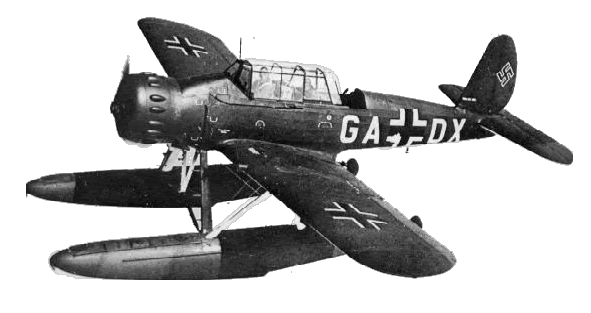The Wings of Children's Dreams
In the books of Tintin Hergé was very careful, very thorough, in the research. The cars are drawn to resemble the real cars, the cities and buildings too. One plane, in particular, captures my imagination. In The Shooting Star, Tintin explores the Arctic region in a beautiful yellow seaplane. I know this is a real plane type, I have done the research.
The model Hergé used was the Arado Ar 196, it was the standard seaplane of the German Navy. Here is the plane as Tintin flew in it, a model of a collector:

And this is the plane in the full uniform:

Europe was then in German control - even though he is writing a story of escape, he is escaping in the beautiful creation of his captors. Even today, children's dreams fly on these wings.
There is more to say of this. A Japanese soldier in Malaysia saw this kind of plane in the war, and told of how graceful its movements were.
The movie he speaks of, Western Union, had Randolph Scott as the star.
Just before lunch yesterday, a two seat float plane of the German Navy paid a visit to our base. The plane was a twin-float low-wing monoplane, a size or two smaller than our Type Zero float plane. This was a recon float plane that belonged to the submarine fleet command stationed in Penang. It touched down gently on the sea about 200 meters off the command post. It was a beautiful touchdown. The plane killed it's speed way low, pulled up near stall, and touched down quietly from the rear end of the floats. It was a surprise for me who firmly believed that we Japanese are much superior than the white people at such delicate operation as bringing a float plane down."Gee, his so good!", I heard someone make an honest comment.
The two German Navy officers appeared at the command post. The pilot was a tough looking man, at least ten years older than I was. He put out his big clumsy looking hand out to our commander, and I wondered how that hand could make such a delicate and gentle landing maneuver.


1 Comments:
Like many things made in the 1930's and early 1940's, aircraft seemed to reach a level of design aesthetics that has been equaled only rarely since:
The Spitfire, the B-17, the DC-3, the Gull-Wing Stinson, the Mosquito, just some of the many extremely beautiful aircraft usually sent to murder each other, directly or indirectly. In that era, beauty seemed to be an effective design strategy; pretty planes often flew better.
It's barely worth mentioning, but modern military aircraft are generally getting uglier and uglier, losing even the brute charm of the A-10 or the C-130. It's generally gone go-bots.
I am hopeful that the 787 will be as elegant as the sketches. It might turn this whole thing around.
Post a Comment
<< Home